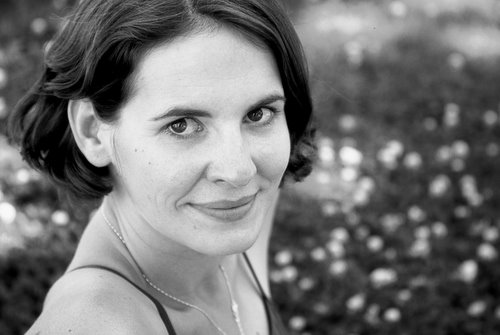Calming for the brain while invigorating for the body
Thursday, October 18, 2007
Saturday, April 28, 2007
Eyes
Yoga teaches us to balance. I am guessing this also applies to our eyes: From now on I will take some time (whenever I remember) to consciously make my right eye the dominant eye.
Like right now. That definitely feels weird.
Isn't the right eye connected to the left brain? Will this make me more creative?
Thursday, April 19, 2007
American Yoga
- sitting in dandasana - rolling the top inner thighs down towards the floor
- extending the spine by elongating and relaxing - this is not a forceful movement. This allows the shoulders to relax into the correct position, rather than pressing it back
- relaxing the trapezius, outer shoulders moving back, armpit chest moving forward and up
- rotating the shin, so that the sole of the foot faces the ceiling and is high up on the thigh (ideally it presses into the abdomen)
- ensuring that the downward movement of the knee originates from the top of the femur.
- pubus moves up, so that the groins can release; lower abdomen moves in and up.
Saturday, April 14, 2007
Leg Lifts
Variation of Malasana to relax the trapezius:
Squatting with your upper arms pressing down on to the knees/thighs. Elongates the trapezius down, away from the ears. Chest lifted.
Padanghustasana - looking up. Instead of thinking "looking up" Ingelise encouraged us to lengthen the throat, the seat of a vayu that is most often blocked.
Adho Mukkha Svanasana
Downward dog with blocks between the inner heels (the soft part of your inner heel, not the ankle)
Flow between Upward and Downward Dog with block between heels; can you roll your toes under in upward dog? Then do the same with block between knees
Downward Dog with block between lower arms
Chataranga with blocks between toes
Urdhva Prasarita Padasana Leg Lifts with block between heels
Jathara Parivartanasana - with block between heel; this teaches to extend through the inner heel and to keep the feet together - not an easy task!
- with partner's foot on the opposite shoulder - helps to keep the shoulder down
- with the thumb and one finger holding the ft of a chair, do this asana without pulling the chair - hard!
Variation of Jathara Parivartanasana - side leg lifts (if tired with bent legs) look up: the action is more in the lower back on the pelvic rim. Looking to the opposite side makes it rajasic in the chest area
Supta Virasana your buttocks on the bolster too, head on second bolster or block: strong stretch in the quads! keep top of shin bone down, knees moving towards each other; open chest. long front body, relaxed throat.
Friday, April 13, 2007
The Science of Yoga

First one has to study the poses. Not studying by reading about them, but by doing them. By experiencing whatever effect they have on us. Often we hear: it's not about who can be the biggest prezel. If it's not that, what is it about?
It's about the energy a yoga pose brings forward. There is nothing to get, there is nowhere to go to. It's already here. Waiting for us to discover it.
We need to understand the three energies that are the fabric of the universe, the three gunas: tama, raja and sattva. Tama is the earth energy: grounding, heavy, still. Its negative aspects are laziness, doubt, hesitation, heaviness. Raja is air; excitement, action, restlessness. Sattva is the peaceful energy that emerges when tama and raja are in balance.
Life is a play, a constant change between these 3 energies. So let's make peace with them and play with these energies! In a yoga pose, let's say tadasana mountain pose, you always want to ground with your feet and legs, that's the tamasic aspect. Tamasic in the positive way, heavy yet strong and engaged. You also want to lift: raja. Lift your chest, lift the sides of your torso equally on both sides. And suddenly there is sattva. Finding that peaceful place in between tama and raja: sattvic energy. An alert, vibrant, peaceful, joyful feeling. That's yoga.
The science of yoga is observing your body, your energy, experiencing how certain poses affect parts of your body or mind. And sometimes this science will turn into art.
"To work with these patterns is to play the music of our own body, our own mind. You count your way into the order of things." N.E. Sjoman
Anatomy
Friday, April 6, 2007
Bec-bending (aka Backbending with Rebecca)
 Rebecca - doing a variation of Dwi Pada Viparita Dandasana on a chair. Is there a name for this variation? This variation is a crazy, intense shoulder opener!
Rebecca - doing a variation of Dwi Pada Viparita Dandasana on a chair. Is there a name for this variation? This variation is a crazy, intense shoulder opener!
 Urdhva Dhanurasana.
Urdhva Dhanurasana.Very important: to extend the chest and lift the thighs, otherwise it is too much in my lower back.

 Urdhva Dhanurasana. Rebecca's wheel is beautiful. Compare the two pictures and you can see how she really opens her chest in the top one. Also her knees are moving towards each other, which protects her lower back.
Urdhva Dhanurasana. Rebecca's wheel is beautiful. Compare the two pictures and you can see how she really opens her chest in the top one. Also her knees are moving towards each other, which protects her lower back. Variation of Dwi Pada Viparita Dandasana on a chair. Get up into headstand, put your feet against the wall and slowly work your way down to the chair. Open chest.
Variation of Dwi Pada Viparita Dandasana on a chair. Get up into headstand, put your feet against the wall and slowly work your way down to the chair. Open chest.






